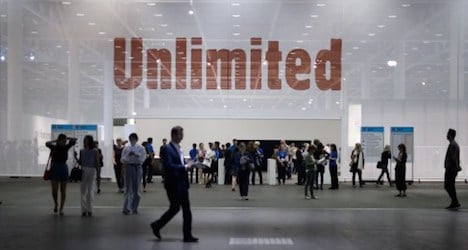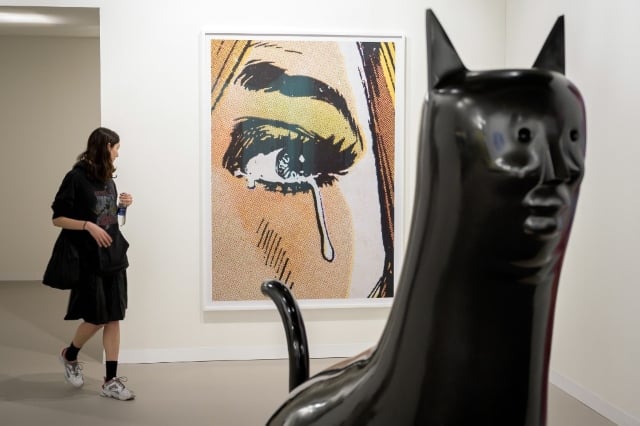The event opens to the public on Thursday, but special VIPs got an advance peek at the vast array of artworks by 20th century masters like Picasso, Calder and Warhol, mixed in with today's cutting edge creations, on Tuesday.
The fair, which last year drew nearly 100,000 visitors from around the world, attracts representatives from museums, large and smaller-scale private collectors and a growing crowd of financial buyers looking for a savvy investment.
“In a world where interest rates are very weak, people are looking for solid value” and are increasingly turning to art, said Juerg Zeltner, head of wealth management at Switzerland's largest bank UBS.
Seated among plush cushions in Art Basel's luxurious VIP lounge, the head of UBS's art sponsorship, Peter Dillon, said the bank — a long-time backer of the fair and a collector with 30,000 pieces to its name — tried to keep its finger on the pulse of the global art market.
“Art education is very important for us internally,” he said, adding that UBS aimed to make its employees “fluent with art and the art market”.
But not everyone appreciates the detached investor's take on art exhibited at the fair.
“People are shopping . . . it's heightened commerciality on an extreme level,” renowned British artist Tracey Emin told AFP.
“I don't like people who buy the work and then flip it,” she said, standing next to a large printed sketch of what looked like a rape scene with the words “Is this a joke” written above it — one of three of her works on display at the Lehmann Maupin booth.
Art Basel director Marc Spiegler also advised against buying works purely with an eye on financial returns.
“My advice for people who want to invest in the art market is buy works that you like, because that way, even if it loses value, you have a work that you like,” he told AFP.
Not just a quick buck
That said, there are hefty profits to be made in a sector that is seeing auction prices go through the roof.
Picasso's “The Women of Algiers,” for instance, sold for a record $179 million at a Christie's auction in London last month, six times what it went for in 1997.
The Art Basel show this year also boasts a number of pricey masterpieces, including a Mark Rothko at the Helly Nahmad gallery booth, carrying a price tag of $50 million.
While the show is important, Spiegler said the value of all the works combined there was “only” around $2 billion, a fraction of the estimated $51-billion global annual art market.
But, for the galleries, the fair is a highlight of the year.
“Sales are extremely strong,” enthused Bona Colonna Montagu of the Skarstedt Gallery, pointing out a large Keith Haring painting from 1984 featuring myriad red interlocking figures that just sold for around $5 million.
She stressed, however, that she refuses to sell works to people only interested making a quick buck, adding: “We don't want to see the piece show up at the auctions in six months time.”
Still, Art Basel is not only for the big spenders. Susanne Milberg, a 52-year-old German national, said she had already snapped up a nice “small-scale” piece for her private collection.
“You can find good, affordable art here too,” she said.
For visitors more interested in looking than buying, a whole 15,000-square metre hall is reserved for the “Unlimited” collection of 74 large and sometimes astonishing works that are not for sale.
Among them is German artist Julius von Bismarck, whose gut-wrenching installation “Egocentric system” shows him sitting, lying and glancing at his mobile phone for hours on end at the heart of a large, spinning concrete bowl, his long beard flowing in the wind.
Next to him, Chinese dissident artist Ai Weiwei's piece “Stacked” is an awe-inspiring tower of 760 bicycles — the iconic object representative of the lives of millions of his countrymen — stacked horizontally.
French-Algerian artist Kader Attia provided perhaps the most powerful work: 16 broken and empty museum showcases, with bricks, rocks and broken glass strewn about, entitled “Arab Spring”.



.jpg)
 Please whitelist us to continue reading.
Please whitelist us to continue reading.
Member comments